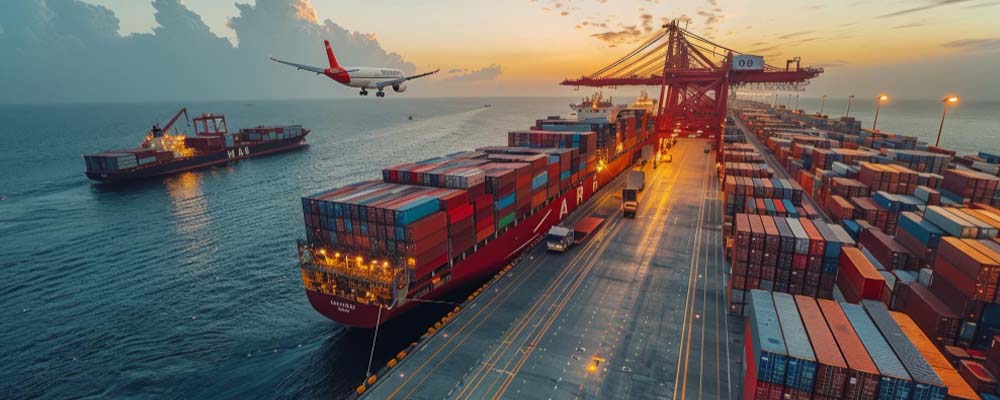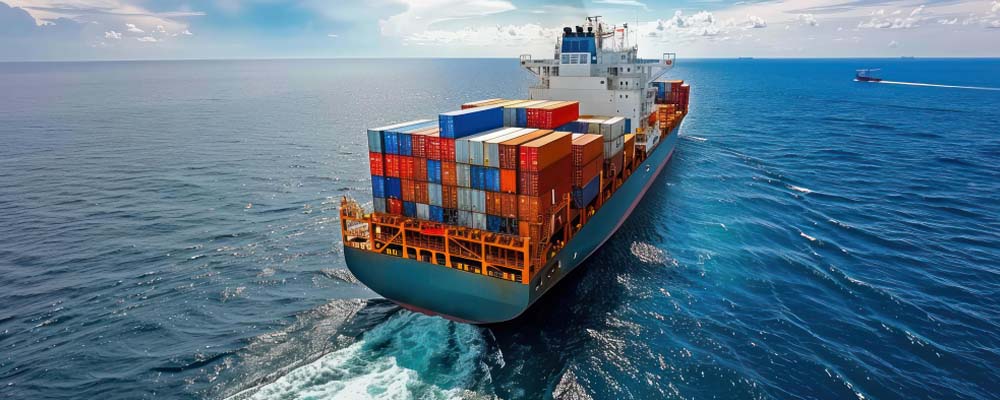 In today’s interconnected world, the efficient movement of goods is crucial for economic growth and development. If you’re involved in the logistics industry, understanding the different types of cargo is essential for optimizing your operations and providing top-notch service to your clients. Whether you’re a freight forwarder, logistics provider, importer, exporter, customs broker, manufacturer, or e-commerce business, knowing your cargo types can make all the difference. Let’s take a deep dive into the fascinating world of cargo shipping and explore the ten different types of cargo you should know about.
In today’s interconnected world, the efficient movement of goods is crucial for economic growth and development. If you’re involved in the logistics industry, understanding the different types of cargo is essential for optimizing your operations and providing top-notch service to your clients. Whether you’re a freight forwarder, logistics provider, importer, exporter, customs broker, manufacturer, or e-commerce business, knowing your cargo types can make all the difference. Let’s take a deep dive into the fascinating world of cargo shipping and explore the ten different types of cargo you should know about.
1. General Cargo
Understanding General Cargo
General cargo consists of individually packaged goods rather than bulk items.These can include anything from electronics to clothing. This type of cargo usually requires careful handling to prevent damage during transportation.
Packaging and Handling
Logistics companies typically transport general cargo in containers or crates to ensure safety. Proper labeling and documentation are essential to avoid mishaps. This type of cargo often requires specialized equipment for loading and unloading, which makes it crucial for logistics companies to have the right tools at their disposal.
Importance in Logistics
General cargo forms the backbone of many industries, making it a common type of freight. Professionals in logistics and freight forwarding must be well-versed in handling general cargo to meet the diverse needs of their clients.
2. Bulk Cargo
What is Bulk Cargo?
Bulk cargo consists of large quantities of unpackaged goods, such as grains, coal, and chemicals. This type of cargo is usually transported in large containers or specialized ships designed to handle bulk materials.
Transport Methods for Bulk Cargo
Bulk cargo requires unique transportation methods, often involving specialized ships known as bulk carriers. These ships are designed to carry large volumes of dry or liquid bulk goods efficiently and safely. Ensuring the proper storage and handling of bulk cargo is crucial to prevent contamination and loss.
Challenges and Solutions
Handling bulk cargo presents specific challenges, such as the risk of spillage and the need for precise measurement. Logistics companies must implement stringent safety protocols and regularly maintain equipment to avoid accidents. Innovations in technology, such as automated loading systems, can help streamline the process and improve efficiency.
 3. Perishable Cargo
3. Perishable Cargo
Defining Perishable Cargo
Perishable cargo includes goods that have a limited shelf life, such as fruits, vegetables, dairy products, and pharmaceuticals. These items require careful temperature control and timely delivery to remain fresh.
Temperature-Controlled Transport
To ensure the freshness of perishable items, temperature-controlled transport methods like refrigerated trucks and containers are employed. These vehicles are equipped with advanced cooling systems to maintain specific temperature ranges throughout the transportation process.
Regulatory Requirements
Transporting perishable cargo comes with strict regulatory requirements to ensure food safety and quality. Adhering to regulations set by agencies like the FDA or USDA is essential for companies involved in the transportation of perishable goods. Non-compliance may lead to substantial fines and significant harm to the company’s reputation.
4. Liquid Cargo
Types of Liquid Cargo
Liquid cargo encompasses a wide range of products, including crude oil, chemicals, and beverages. These goods are typically transported in tankers or specialized containers to prevent leaks and spills.
Specialized Transport Equipment
Transporting liquid cargo requires specialized equipment, such as tanker ships, tank trucks, and ISO tanks. These containers are designed to handle the unique properties of liquids, including their viscosity and flammability.
Safety Considerations
Safety is paramount when transporting liquid cargo. Companies must adhere to strict safety protocols to prevent accidents, such as leaks and spills. Regular inspections and maintenance of transport equipment are essential to ensure the integrity of the containers and the safety of the cargo.
 5. Hazardous Cargo
5. Hazardous Cargo
Identifying Hazardous Cargo
Hazardous cargo includes materials that pose a risk to health, safety, or the environment. Examples include explosives, flammable liquids, and toxic substances. Transporting hazardous cargo requires meticulous planning and strict adherence to regulations.
Regulatory Compliance
Transporting hazardous materials is governed by stringent regulations, such as the International Maritime Dangerous Goods (IMDG) Code and the Hazardous Materials Regulations (HMR). Compliance with these regulations is essential to ensure the safety of the cargo and those involved in its transportation.
Risk Mitigation Strategies
Logistics companies must implement robust risk mitigation strategies when handling hazardous cargo. This includes proper labeling, adequate training for personnel, and the use of specialized equipment. Emergency response plans should also be in place to address any incidents that may occur during transportation.
6. Break Bulk Cargo
What is Break Bulk Cargo?
Break bulk cargo consists of items that are too large or heavy to be transported in standard shipping containers. Examples include machinery, vehicles, and construction materials. These items are typically transported individually or in smaller units.
Transport Challenges
Transporting break bulk cargo presents unique challenges, such as the need for specialized handling equipment and increased labor costs. Proper planning and coordination are essential to ensure the safe and efficient transportation of break bulk cargo.
Solutions for Efficient Transport
To overcome the challenges associated with break bulk cargo, logistics companies can invest in specialized equipment and training for their personnel. Collaborating with experienced freight forwarders can also help streamline the process and ensure the safe delivery of break bulk items.
7. Containerized Cargo
The Rise of Containerized Cargo
Containerized cargo refers to goods transported in standardized containers, making it one of the most common methods of shipping today. These containers come in various sizes and can be easily transferred between different modes of transport, such as ships, trucks, and trains.
Benefits of Containerization
Containerization offers numerous benefits, including improved efficiency, reduced handling time, and enhanced security. The use of standardized containers also simplifies the logistics process, making it easier to manage and track shipments.
Innovations in Container Shipping
Recent innovations in container shipping, such as smart containers equipped with tracking technology, have further improved the efficiency and security of containerized cargo. These advancements allow logistics companies to monitor the location and condition of their shipments in real time, ensuring timely delivery and reducing the risk of loss or damage.
8. Project Cargo
Understanding Project Cargo
Project cargo involves the transportation of large, complex, and often high-value items, such as industrial machinery, wind turbines, and infrastructure components. This type of cargo requires meticulous planning and coordination due to its size, weight, and complexity.
 Planning and Execution
Planning and Execution
Successfully transporting project cargo involves detailed planning and execution. This includes route surveys, risk assessments, and obtaining necessary permits. Collaboration with experienced logistics providers and specialized carriers is crucial to ensure the safe and efficient delivery of project cargo.
Case Studies and Examples
Numerous case studies highlight the successful transportation of project cargo. For example, the delivery of massive wind turbine components to remote locations requires careful planning and coordination to overcome logistical challenges. By leveraging the expertise of experienced logistics providers, companies can ensure the successful completion of these complex projects.
9. Oversized Cargo
Transporting Oversized Cargo
Oversized cargo includes the transportation of large items that cannot be easily moved using standard shipping methods. This type of cargo requires specialized handling and care to ensure safe and efficient transit.
Safety Considerations
Ensuring the safety of oversized cargo during transport is of utmost importance. This involves proper securing, adequate space, and compliance with transportation regulations to prevent damage and accidents.
Best Practices for Oversized Cargo Transport
Best practices for transporting oversized cargo include thorough planning for route and permits, using appropriate transport vehicles, and regularly monitoring the condition of the cargo. Implementing these practices helps ensure the safe and efficient transportation of oversized cargo.
10. Heavy Lift Cargo
Characteristics of Heavy Lift Cargo
Heavy lift cargo refers to exceptionally large and heavy items, such as industrial equipment, construction machinery, and large vehicles. Transporting this type of cargo requires specialized equipment and expertise.
Specialized Equipment and Techniques
Handling heavy lift cargo involves the use of specialized equipment, such as cranes, hydraulic jacks, and reinforced trailers. Advanced planning and coordination are essential to ensure the safe and efficient transportation of heavy lift cargo.
Industry Examples
Industry examples of heavy lift cargo transport include the delivery of large construction cranes to job sites and the transportation of massive industrial equipment for manufacturing facilities. These complex operations highlight the importance of specialized expertise and equipment in handling heavy lift cargo.
 Conclusion
Conclusion
Understanding the different types of cargo is crucial for logistics professionals and businesses involved in the transportation of goods. Each type of cargo presents unique challenges and requires specialized knowledge and equipment to ensure its safe and efficient transportation. By familiarizing yourself with these cargo types, you can optimize your logistics operations, enhance customer satisfaction, and stay competitive in the dynamic world of global trade.
For those seeking to elevate their logistics game, consider partnering with trusted experts in the field. Schedule a consultation with our team to explore tailored solutions for your business. Let’s make the world of cargo shipping work for you!




 3. Perishable Cargo
3. Perishable Cargo 5. Hazardous Cargo
5. Hazardous Cargo Planning and Execution
Planning and Execution Conclusion
Conclusion



